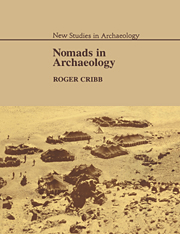Book contents
- Frontmatter
- Contents
- List of illustrations
- List of tables
- Preface
- 1 Introduction
- 2 Origins and definitions
- 3 Nomad pastoral economy
- 4 Residence, descent and territory
- 5 Nomads – the invisible culture?
- 6 Nomad architecture and domestic space
- 7 Ali's camp: a nomad household campsite
- 8 The structure and location of nomad settlements
- 9 Sariaydin Yayla
- 10 The lost world of Nemrut Daḡ
- 11 Nomad archaeology: an assessment
- 12 Towards a model of unstable settlement systems
- References
- Glossary
- Index
10 - The lost world of Nemrut Daḡ
Published online by Cambridge University Press: 23 September 2009
- Frontmatter
- Contents
- List of illustrations
- List of tables
- Preface
- 1 Introduction
- 2 Origins and definitions
- 3 Nomad pastoral economy
- 4 Residence, descent and territory
- 5 Nomads – the invisible culture?
- 6 Nomad architecture and domestic space
- 7 Ali's camp: a nomad household campsite
- 8 The structure and location of nomad settlements
- 9 Sariaydin Yayla
- 10 The lost world of Nemrut Daḡ
- 11 Nomad archaeology: an assessment
- 12 Towards a model of unstable settlement systems
- References
- Glossary
- Index
Summary
Yet not a single Kurdish tent, no shepherd, no wayfarer can we descry in the wide landscape of the volcanic basin. We observe paved holes in the ground where it is evident that bread has recently been baked. There are stone enclosures for penning cattle. More and more clearly we realize that the crater must be inhabited and that this floating population have decamped at the approach of the soldiers.
(Lynch 1901, pp.303–4)The setting
Having climbed the 2,000 metres or so from the shores of Lake Van to the rim of the crater of Nemrut Daḡ, the traveller is treated to an awesome sight. Below stretches a huge basin surrounded on all sides by precipitous walls. The interior is a tumbled chaos of conical hills, lava flows, depressions and jagged outcroppings of rhyolitic rock and obsidian, its western half drowned by the icy waters of a large semicircular lake. Nemrut Daḡ is a collapsed caldera, the remnant of a lofty volcano which emerged from the floor of the plateau to dam up the waters of Lake Van to the east. It is one of a chain of volcanic eminences lying to the north of the folded ridges of the Taurus Mountains – Ararat and Süphan to the east, Bingol, Erciyas and Hasan Daḡ further west.
- Type
- Chapter
- Information
- Nomads in Archaeology , pp. 185 - 211Publisher: Cambridge University PressPrint publication year: 1991

